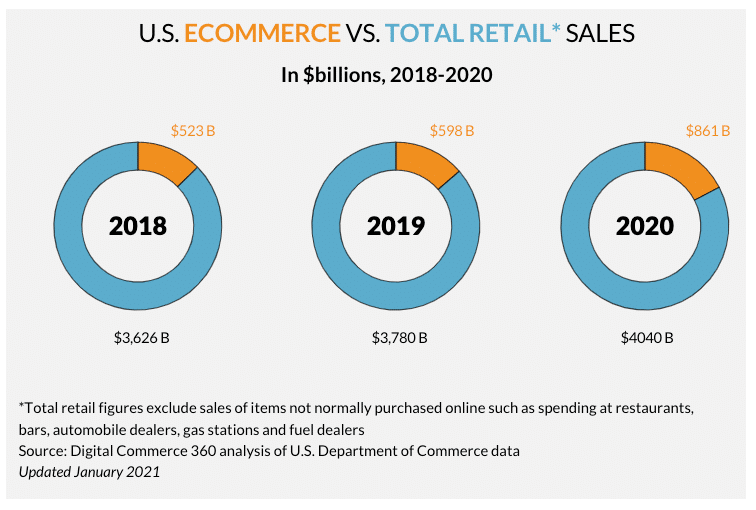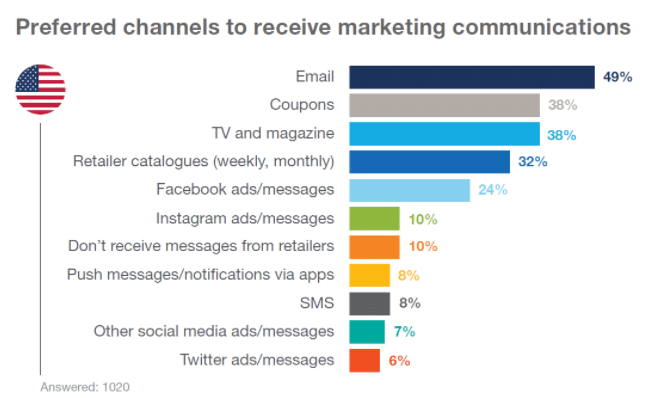Ecommerce marketing needs constant improvement and refinement if you want to increase ecommerce sales. Luckily, there are a variety of tested-and-proven tactics you can implement to drive conversions and make your ecommerce brand soar. Continue reading for our top eight ways to increase ecommerce sales, as well as some tips on how to do it quickly.
How Ecommerce Sales are Increasing
8 Ways To Increase Ecommerce Sales
1. Integrate Social Media
Social media marketing is a powerful tool that can help give your ecommerce brand some extra mileage. You can leverage social by integrating it into your ecommerce marketing strategy, so that you’re reaching as many people as possible. Here are some tips on how to do this:
-
- Choose the social media platforms that are most relevant to your audience. For example, if you’re targeting younger audiences, social media platforms like Twitter, Instagram or TikTok might be most relevant. For B2B businesses or if you’re targeting later-in-life professionals, you might find more success on Facebook or LinkedIn. Do your research and make sure to focus your efforts on the platform that your audience actually uses – meet your customers where they are.
- Take advantage of social media shopping to drive conversions. This form of online shopping is seeing a massive increase in 2021, and provides an extremely convenient way for consumers to buy a product without leaving social media. In fact, Instagram Shopping rakes in around 800,000 consumers every month, so integrating your online shop with social media could significantly boost your ecommerce sales.
- Use social media management platforms to auto schedule posts. Platforms like Hootsuite, Sendible, or Sprout Social are great for regularizing your content and making sure that you keep your ecommerce brand at the forefront of your followers’ news feeds. Platforms like these also give you insights and analytics about your followers’ online behavior, including how they interact with your content, and what kinds of content they engage with the most.
- Use social media analytics to create targeted ads. Even if you’re not using a social media management platform, sites like Facebook and Instagram have a range of analytical tools available to businesses that can inform your social media marketing campaigns. For example, you can use the data you get from the social platform you use to create social media ads that are tailored to your ideal customer demographic, as well as to refine your content so it’s as relevant as possible.
2. Use the Data – Maximize Learnings from Website Analytics
Just like social media analytics, you can use your website analytics to better understand your customers, tweak your ecommerce marketing plan, and sharpen your strategy. Site analytics provide valuable data about your visitors by measuring a range of metrics, including but not limited to:
- Dwell time or bounce rate – how long people tend to stay on a page for
- Cart abandonment rate – how many visitors are abandoning their shopping cart without purchasing
- Traffic source – where most of your leads are coming from, such as social media, organic traffic or ads
- Conversion rate – how many site visitors are converted into paying customers
- Average order value (AOV) – the amount of money spent on an average order
Knowing this kind of information will allow you to continually tailor your website so that it meets the needs of your audience. For example, understanding your AOV will help your pricing strategies, while knowing the source of your traffic will highlight which platforms your marketing campaigns will be most effective on. Understanding these key metrics helps you use your marketing budget in the most efficient way possible.
3. Use Promotional Offers
Site visitors can need a lot of persuading before they’re willing to make a purchase or commit to a subscription. This is where promotional offers come in. You can use offers to incentivize your audience into buying your product, as well as to demonstrate that you value their business and are confident in the quality of what it is you’re offering.
One of the most common kinds of promotional offers are freemiums, wherein a basic product is offered for free, but with different tiers of pricing available for premium features. Free trials that run for a limited time are also very popular because they give the consumer a real, no holds barred experience of your product, without tying them into a commitment.
Another example of promotional offers that help to increase ecommerce sales are referral schemes, which encourage consumers to recommend your product to a friend in return for a reward, like a discount. This is also effective because of the recommendation itself – people tend to trust other people more than companies when it comes to making purchases.
4. Create Useful and Authentic Content
When marketing for ecommerce, one of the most organic ways to boost sales is to provide useful and authentic content that provides value to your ideal customer. Instead of hyping your brand or relying on exaggerated claims, be truthful about your product so you can manage customer expectations and (fingers crossed) keep them coming back. Remember, it’s always better to understate a product and overdeliver, than it is to overstate a product and underdeliver.
When it comes to creating relevant, engaging content, think about what problem or challenge it is your target audience are trying to solve, and how your product does that. Why do they need your product, or what value does your product bring to them? How does it meet their needs and desires? Does it provide a solution to a commonly-felt problem? Use the answers to these questions to provide content that your audience finds relevant and useful. Here are some good examples:
- Interactive content. This can be something like a quiz that helps a consumer identify which product they need most, or even a 360 product viewer that allows customers to get up-close-and-personal with your product. A great example of this is by Under Armour, who use 360 degree views to show off every inch of their trainers and entice you to buy.
- Lifestyle and brand story blogs. Telling your product or brand story in an engaging and honest way helps to draw potential customers in on an emotional level – and emotions play a big part in the purchase process. It also helps to build trust, make a connection, and show your personality.
- Articles about related topics. Diversifying your content (without straying too far from the topic!) is a key way to establish yourself as an authoritative voice. This is because providing extra information helps customers see you as experts in your field. For an online cosmetics shop, this could include content on how certain products are made, or which are the favorites in the industry right now. For an online plant shop, articles could revolve around providing more information about different plant species.
- Video. Creating video content is one of the most powerful ways to engage with your audience. In fact, video content on landing pages can boost ecommerce conversion rates by 80%. Meanwhile, 90% of consumers say watching videos helps them make a purchase decision. Those two statistics alone (and there are plenty more) should be enough to convince you that video can massively increase ecommerce sales.
Providing creative and useful content will help to establish your brand’s credibility, as well as develop trust and rapport with your customers. You’re also far more likely to receive repeat transactions and recommendations from your existing customers if you’ve used a well-thought-out content marketing strategy, as it identifies you as an authoritative source in your industry.
5. Digital Ad Spend
While focusing on organic traffic and search engine optimization (SEO) is probably the best way to legitimately grow an online brand, it can take months before your online shop even starts to break through the SERPs (search engine results pages). To get the ball rolling, it’s worth spending some of your budget on ad campaigns, like Google Ads or PPC (pay-per-click). These can be quite cost-effective ways of increasing your ecommerce sales without breaking your budget.
Using something like Google Ads, for example, will allow you to strategically target your audience in a number of ways, whether it’s through search ads, shopping ads, or display ads. You can also define who your audience is, where you want your ad displayed, and what you want to optimize your ad for, be it for increased site traffic or increased sales.
If you want to increase your ecommerce sales, you can also make use of social media ads to reach an even wider audience. For example, you can make ads click-through to a product page, making the buyer’s journey that much easier and more accessible. In a nutshell, spending a bit of your marketing budget on ads can be a really effective way to attract leads to your online shop – and once you have a good customer base going, improving organic traffic will be that much easier.
6. Use Email Marketing
It may surprise you to know that email marketing has a relatively higher conversion rate compared to targeted ads on social media. This is because when someone has subscribed to your email list, they already have an affinity with your brand, and this makes them more likely to be receptive to your content.
In terms of where they are in the marketing funnel, email subscribers are already in the middle part of their buyer journey: they have agreed to be notified about any updates from your website, including sales offers, and are expecting to hear from you. Put simply, they’re interested in what you have to offer. Leverage this by creating thoughtful email marketing campaigns that promote your products, offer exclusive insights or discounts, and directly link to your website or product page. Here are some things you can do to drive ecom sales through email marketing:
- Use high-converting email templates
- Personalize your emails
- Include clickable CTAs to encourage website traffic
- Send out creative reminders about abandoned carts
- Automate ‘Happy Birthday’ or holiday messages
7. Simplify The Checkout
Simplifying the checkout process for your online shop is crucial to increasing ecommerce sales. In a digital world of instant gratification, online shoppers are getting increasingly particular about the checkout process, and this is made obvious through shopping cart statistics. Did you know, for example, that the current shopping cart abandonment rate is 69%?
Most online shoppers don’t have the patience to fill out long and complicated forms, so make sure that you’re not including any unnecessary form fields on your checkout page, or complicating it in any way. Instead, look at ways you can optimize your checkout process while still gaining important data.
For example, rather than forcing new customers to create an account before making a purchase, which can be particularly off-putting to mobile users, create an option to sign-up via Facebook or Google, or to simply provide their email and checkout as a guest. This will encourage them to complete their purchase, but will also gather important customer data that you can then utilize in the future.
It’s also worth testing the user experience on your checkout page. Are there distractions, or other links that customers might be tempted to click on? How long does it take to check out? How many clicks does it take to make a purchase?
Take Amazon, for example. Once you’re in their checkout, the top navigation bar and footer disappear, leaving an uncluttered page with clear details of your purchase and two calls to action to buy now. For instance:
- This is the product I want to buy.
- I add it to my basket, and I immediately see two strategically-placed calls to action to proceed to checkout (but I might be tempted to purchase something similar or make a repeat purchase, too).
- Once I proceed to checkout, the header and footer disappear, and I’m left with a clean purchase page that has one single goal – to make sure I click the ‘Buy now’ button.
8. Implement Split Testing
More commonly known as A/B testing, split testing allows you to enhance the user experience by comparing and analyzing two areas of a marketing campaign in order to see which one performs best in terms of:
- Engagement
- Quality scores
- Click-through-rates
- Number of purchases
- Site metrics, like conversion or bounce rates
You can split test most elements of an ecommerce marketing campaign, including different types of Google ads or PPC ads, email campaigns, graphics, or CTAs. You can even split test different versions of landing pages you have to see which provides a better overall user experience.
The goal here is to analyze each platform you’re comparing, and use the statistics you collect to determine which option is most effective in achieving your specific goal, which provides a more optimized performance, and which one prospects respond to. This will help you optimize your ecommerce strategy according to the behavior of your target audience.
Tips For Increasing Ecommerce Sales Quickly
So, you know how to drive conversions and increase sales, but how do you do this quickly? A fast turnaround and ROI can be critical to any brand’s success, so here are some top tips on how to increase ecommerce sales quickly:
- Think about the ecommerce conversion funnel in your ecommerce marketing strategy. This will give you a guideline on how to design and optimize your ideal customer’s journey. Consider how you’ll make them aware of your product, what you can do to pique their interest, how you can create desire about your product, and what you can do to drive action.
- Focus on site visitors who are already in the middle or at the bottom of the marketing funnel. At these stages, consumers will be more receptive to persuasive approaches. Creating demo videos is a great way to move leads further down the sales funnel, as well as providing articles that shine a light on how your product will better meet their needs than other competitors.
- Create a sense of urgency. This ecommerce marketing tactic will make your site visitors more likely to purchase sooner rather than later. The less research a customer needs to do about a product (or the more information they can easily find and instantly digest), the more willing they are to make a purchase. Similarly, creating urgency or a sense of exclusivity, like CTAs (calls to action) for low-in-stock items or discounted products, is also an excellent way to give people that final reason to make a purchase.
- Be strategic in your follow ups. Staying in touch with your email subscribers and social media followers is essential if you want to boost your sales. Whether it’s asking about their experience, or recommending new products based on their order history, following up with your leads is important if you want to foster good relationships and retain customers.





